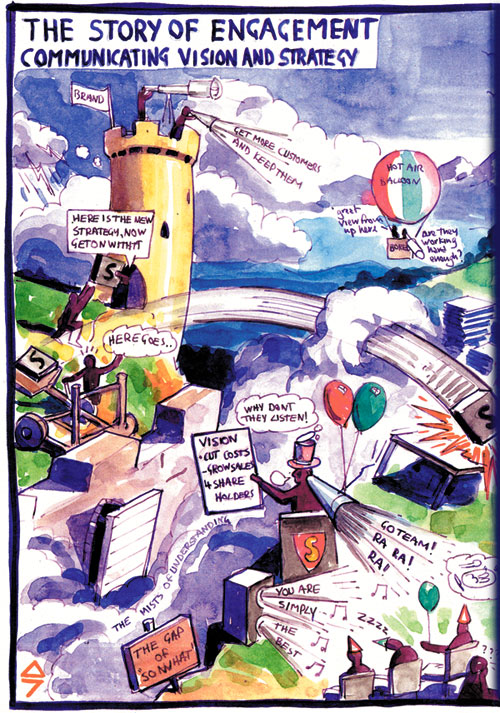Implementation: Communicating Strategies
Implementation: Communicating a Strategy
As we have heared in the previous chapter the problem is often not bad strategy but bad execution. The process of communicating a strategy has been neglected. What has been underestimated so far is that a strategy can not be simplified to one picture or photo, as we know it from advertising campaigns. We have to give the employes the chance to understand relationships and see the big picture. What we have seen in many projects is that people connotate the term "Strategy" with strange associations and as soon as we use the words strategy, people start to talk about Porter, Drucker or the difference between a mission and vision. The discussion tend to become very serious general. In this situation we have experience in a series of projects that the use of visualizations can help.
In one organization 15 posters (120x80cm) where used in a management workshop with 200 managers to illustrate the idea behind the 15 statements. The 15 posters together formed a large wall (600cmx240cm) which was later exhibited in the lobby of the headquarter. Unfortunately we can not show the images. However, on each image there was a skyline and one keyvisual like a watch, a flower, etc. in the foreground. On the top of the image there was a headline with the statement in large letters.
Another approach is the use of maps, as we will see it in the case studies Science City and ETH Strategy in the next chapters.
Again another approach is the use of sketches or handdrawn maps, as the following one:
The example has been described by Angela Jameson in the Times (October 21, 2006):
"Drawing the big picture by keeping things simple
BAE Systems used art to communicate its strategy.
BAE SYSTEMS had a problem. For years it had provided support to the RAF, but what the customer wanted was changing. Instead of fixing the fighter jet when it developed a fault, it was cheaper for the RAF to pay to have replacement fighter jets always available.
For BAE Systems’ CSS, MASS division — customer solutions and support, military air solutions and support — it was the motoring equivalent of changing from Kwik-Fit to Avis, from merely mechanics to providers of hire cars, always ready and fuelled to drive off in.
But, according to an internal survey in 2004, less than 50 per cent of the workforce understood the business strategy. The division urgently needed a way of communicating it. It was at this point that Julian Burton, an artist who specialised in drawing complicated ideas, got involved. The result was a visual interpretation of the strategy that could be taken around the group’s 3,000 workers.
“We didn’t just want it to describe the strategy but to generate a conversation about what it meant. It was to be a force for change and would show what would happen in the future, and the individual’s place in it,” says Andrea Adams, human resources director of the division.
Mr Burton says: “I start off by talking to the senior team. I act the naïve staff member and ask questions such as ‘What do you mean by striving for excellence? How does it feel? What does it look like?’ This stage can be challenging and quite uncomfortable for leaders,” he says. Then the first draft of the picture is tested on staff.
With BAE Systems, it was clear that employees were weary with constant initiatives, generated either by the customer, the Ministry of Defence, or the management. “I was showing the picture to engineers and their first reaction was ‘Uh-oh, here’s another one’. So I put that in the picture with a little guy saying ‘Oh no, not another strategy’. ”
Mr Burton has worked for 60 companies since he began his management consultancy business, many of them leading FTSE 100 players, and he has found a rich seam of problems that keep him in work. “It is almost universal that, for senior people, communication is a one-way system. That means the workforce can’t make sense of what is being asked of them,” he says.
At BAE Systems, the picture had a dramatic impact on the workforce’s comprehension of the strategy. After 150 copies of the picture were discussed, understanding shot up to 82 per cent.
Management believes it has also had an impact on the bottom line. “The business has grown by 40 per cent in the past two to three years. In the view of the board, a lot of this success is down to the engagement process,” says Ms Adams."
(Source: http://business.timesonline.co.uk/article/0,,9067-2414284,00.html)
All these examples aim at giving you ideas how to improve the communication of a strategy. We have seen that today's practice to delegate the strategy documents to the internal communication departement is not enough. The CEO or Chief or Strategy himself hasto invest time and money in the process of communicating the strategy. And you have seen that there is a lot to be done. The field is new and very important and it is you that could be come the mister or misses "Strategy Visualization" of the world. We encourage you to get active!